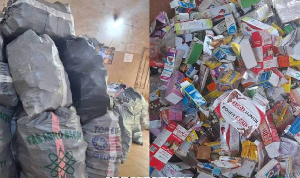Yaounde — Every day, Paulina Abena and her two grown-up daughters criss-cross the neighbourhoods of Yaounde carrying 40-litre (11 US gallon) containers.
They are searching for drinking water, an increasingly scarce commodity in Cameroon's capital since the government introduced rationing in response to a prolonged drought and inadequate water infrastructure.
"For over five months, the taps in my house have run dry," says Abena. The 46-year-old brews a local drink, "kwatcha", from fermented maize to sell at a nearby market.
"Without water this business cannot function, so we have to trek sometimes as far as 10 km (6 miles) in search of drinking water," she adds.
The sight of women and children walking long distances to find drinking water has become a familiar one in Yaounde and in many African cities, a situation environmental experts blame on increasingly severe dry seasons, surging urban populations and lack of investment in water infrastructure.
"When dry periods go longer than usual, sources of water dry up, as we have seen with the diminishing water volume of the Nyong River in Yaounde and Lake Chad, and this leads to a water supply shortage," said Zachee Nzohngadembou, executive director of the Centre for the Environment and Rural Transformation, a nongovernmental organisation in Limbe.
The tortuous daily trek of Abena and her daughters, and many others like them, is the result of temporary rationing measures introduced by the government, with each neighbourhood taking its turn to receive water once a week.
Announcing the measure over state radio and television in February, the government delegate to the Yaounde city council, Gilbert Tsimi Evouna, noted that the city's more than 3 million inhabitants require a daily water supply of over 300,000 cubic metres (about 80 million gallons).
Statistics from the state water company, Camerounaise Des Eaux, show that Yaounde has a supply gap of about 200,000 cubic metres a day. The main source, Nkomyanda water treatment station, supplies 100,000 cubic metres a day, while the Akumnyada treatment centre produces just 100 cubic metres.
CREATING MORE PROBLEMS
The rationing has proved very unpopular, and residents say it is causing more problems than it solves.
"There is no clear distribution calendar. Even when it is the turn of some neighbourhoods to get water in the rationing process, supplies are made selectively, sometimes late in the night, forcing households to stay up waiting," said Enjeuma Esthel, 42, a housewife in the Obili neighbourhood.
Those who are fortunate enough to get water do a brisk business re-selling it to those who are without.
Massing Dieudonne, a teacher who lives at the Mimboman neighbourhood, on the flanks of one of the hills surrounding the city, said he sells water at double the price of 65 Central African francs (about 13 cents) per 1,000 litres charged by Camerounaise Des Eaux.
According to Dieudonne, who also has access to a borehole, he makes about 15,000 CFA (about $30) a day with his sales.
Only about 30 percent of Cameroon's 20 million inhabitants have access to piped drinking water, according to government statistics.
Many households resort to water from boreholes, which must be treated before drinking.
"The risk of malaria, fever and water-borne infections is high," said Casimir Youmbi, emergency response manager for the Cameroon office of Plan, an international children's charity. "Living conditions are poor (and) unsanitary, and the over-crowded population makes matters even worse," he added.
In 2012 over 250 deaths from cholera in Yaounde were reported by the government. The rapid spread of the epidemic and high mortality rate were due to poor hygiene conditions and lack of access to clean drinking water, according to Plan Cameroon.
Statistics from the Ministry of Water and Energy show that have been no major investments in water treatment in Yaounde over the past 25 years.
The government has blamed this on the country's economic crisis over the last two decades, which it says led to a freeze in state spending on major development projects.
But some think it is a matter of misplaced development priorities. Kah Wallah, leader of the Cameroon People's Party, one of the main opposition parties, has called on Cameroonians to wear black every Friday as a sign of protest to force the government address the water crisis.
"Water is life. We need water and electricity, basic necessities that should take priority in government spending," Wallah said.
The minister of water and energy, Basil Atangana Kouna, recently announced measures to address the problem, including a new Mefou water treatment station which is due to become operational by August of this year.
"This project will inject an additional 50,000 cubic metres of water per day into Yaounde. Though this is not sufficient to fill the shortage, it will narrow the gap while waiting for bigger projects," he assured.
In 2012, the government approved a water investment programme worth over 600 million euros ($785 million) as part of a broader economic development effort.
Elias Ntungwe Ngalame is an award-winning environmental writer with Cameroon's Eden Group of newspapers.
Actualités of Thursday, 6 June 2013
Source: AlertNet












